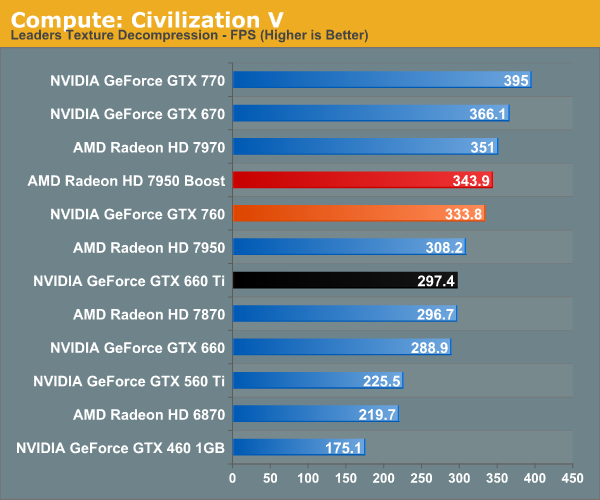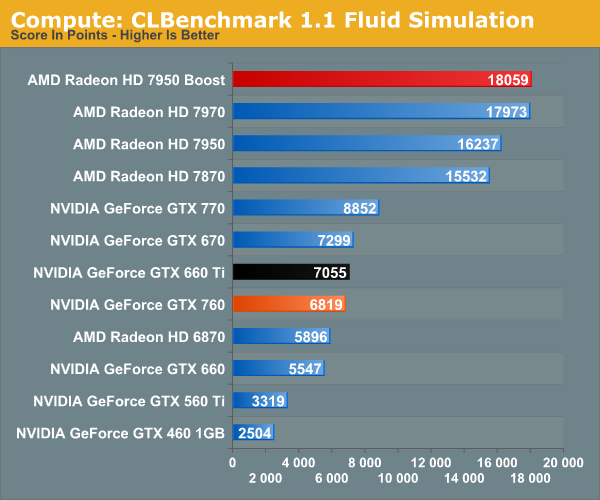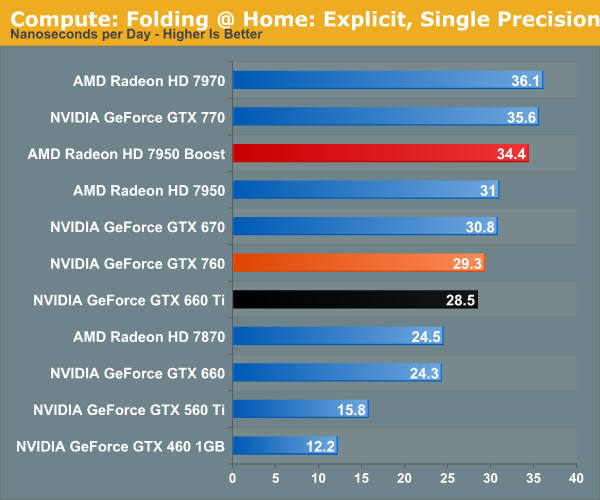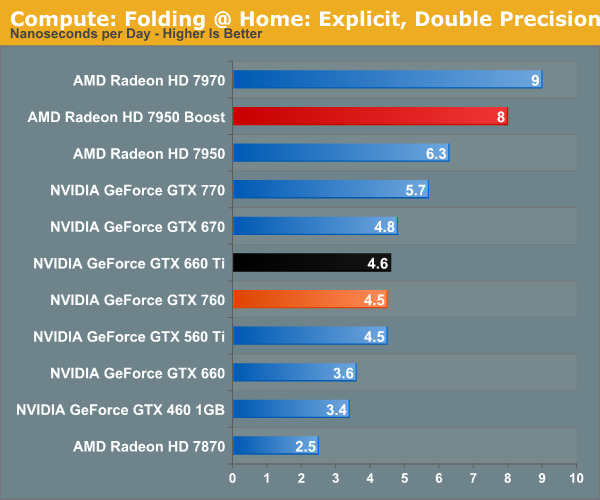NVIDIA GeForce GTX 760 Review: The New Enthusiast Kepler
by Ryan Smith on June 25, 2013 9:00 AM ESTCompute
Jumping into compute, we aren’t expecting too much here. Outside of DirectCompute GK104 is generally a poor compute GPU, and the loss of an SMX relative to the GTX 660 Ti isn’t doing the GTX 760 any favors here. By all appearances the GTX 760 is even more of a pure gaming card than the GTX 660 Ti was.
As always we'll start with our DirectCompute game example, Civilization V, which uses DirectCompute to decompress textures on the fly. Civ V includes a sub-benchmark that exclusively tests the speed of their texture decompression algorithm by repeatedly decompressing the textures required for one of the game’s leader scenes. While DirectCompute is used in many games, this is one of the only games with a benchmark that can isolate the use of DirectCompute and its resulting performance.

Civilization V once more validates that NVIDIA’s DirectCompute performance is generally up to snuff in this case. The fact that the GTX 760 is ahead of the GTX 660 Ti by any degree took us by surprise at first, but we’re likely looking at a scenario where the wider memory bus and/or larger L2 cache of GTX 760 offset some of the general compute gap.
Our next benchmark is LuxMark2.0, the official benchmark of SmallLuxGPU 2.0. SmallLuxGPU is an OpenCL accelerated ray tracer that is part of the larger LuxRender suite. Ray tracing has become a stronghold for GPUs in recent years as ray tracing maps well to GPU pipelines, allowing artists to render scenes much more quickly than with CPUs alone.

Luxmark is entirely about compute performance, and as a result this is an exceptionally poor showing for the GTX 760, with the GTX 660 Ti having no trouble besting it.
Our 3rd benchmark set comes from CLBenchmark 1.1. CLBenchmark contains a number of subtests; we’re focusing on the most practical of them, the computer vision test and the fluid simulation test. The former being a useful proxy for computer imaging tasks where systems are required to parse images and identify features (e.g. humans), while fluid simulations are common in professional graphics work and games alike.


Breaking down our CLBenchmark results, the computer vision test has frequently favored raw clockspeed over total shader throughput, which gives the GTX 760 an interesting advantage here. It’s capable of easily leaving the GTX 660 Ti in the dust and even edge out the GTX 670. Of course this is still less than 2/3rds the performance of even the slowest AMD GCN card, reflecting AMD’s superior computer performance.
The fluid simulation is especially brutal in that regard. Once again shifting back to an almost complete reliance on shader throughput, GTX 760 slightly trails GTX 660 Ti, never mind the nearly three-fold difference between it and the 7950B.
Moving on, our 4th compute benchmark is FAHBench, the official Folding @ Home benchmark. Folding @ Home is the popular Stanford-backed research and distributed computing initiative that has work distributed to millions of volunteer computers over the internet, each of which is responsible for a tiny slice of a protein folding simulation. FAHBench can test both single precision and double precision floating point performance, with single precision being the most useful metric for most consumer cards due to their low double precision performance. Each precision has two modes, explicit and implicit, the difference being whether water atoms are included in the simulation, which adds quite a bit of work and overhead. This is another OpenCL test, as Folding @ Home has moved exclusively to OpenCL this year with FAHCore 17.


Unlike some of our other compute benchmarks, the GTX 760 doesn’t fare too poorly here when it comes to single precision. However it’s still notably behind the 7950B in this case. And with double precision it’s no contest.
Wrapping things up, our final compute benchmark is an in-house project developed by our very own Dr. Ian Cutress. SystemCompute is our first C++ AMP benchmark, utilizing Microsoft’s simple C++ extensions to allow the easy use of GPU computing in C++ programs. SystemCompute in turn is a collection of benchmarks for several different fundamental compute algorithms, as described in this previous article, with the final score represented in points. DirectCompute is the compute backend for C++ AMP on Windows, so this forms our other DirectCompute test.

As another compute throughput bound benchmark, the GTX 760 is essentially tied with the GTX 660 Ti. This benchmark is somewhat memory bandwidth sensitive, which is why the GTX 760 doesn’t outright lose to the GTX 660 Ti here.










110 Comments
View All Comments
DanNeely - Tuesday, June 25, 2013 - link
The 8800 Ultra was a $650 card. Ignoring the Titan we're back where we were 7 years ago.nsiboro - Tuesday, June 25, 2013 - link
AMD delaying Sea Island until Q3'2013...I just feel someone over @AMD is crazy and didn't think thru end users' point of view.
With the release of Haswell, many will be putting together new boxes and the "new" GPU they'll get will be gtx760/770/780. AMD losing fans and revenue... *sigh*
silverblue - Tuesday, June 25, 2013 - link
I'm not sure I follow. Haswell doesn't appear to have amazed that many people - you could get away with an SB or IB build which overclock enough to make up the performance difference. If you already have one of those, with proper cooling you don't need to save money for a marginally better CPU - spend it on graphics instead.DanNeely - Tuesday, June 25, 2013 - link
It's not the SB/IB people upgrading; it's those of us with first generation i5/i7 systems or even older core 2 quads pulling the trigger now. AMD is out of the race except at the bottom and it's probably going to be two more years before Intel offers anything else worth mentioning on the desktop. (No socketed Broadwell chips, and assuming IVB-e and Haswell-e are as underwhelming at the $3xx pricepoint as SB-e is.)Dark_wizzie - Tuesday, June 25, 2013 - link
I wished it included a benchmark with Skyrim on 2560x1440, with the hardcore texture mods on, AA/AS on pretty high with Ultra. Debating between this ($250), 7970... ($310!!!), 770 ($400)Ryan Smith - Tuesday, June 25, 2013 - link
You request will be taken under consideration, but I'll tell you right now that you shouldn't expect it to happen. One of the tenets of our testing methods is that we don't test with mods; they're often not optimized (or worse, optimized only for the developer's system) and frequently updated (making our benchmarks useless). Plus the number of users on any given mod is very low, which would mean our benchmarks wouldn't be very applicable to most of our readers.edlee - Tuesday, June 25, 2013 - link
something tells me if you SLI two GTX 760 it would destroy the GTX 780 at a lesser pricexTRICKYxx - Wednesday, June 26, 2013 - link
Google some benchmarks. It goes toe-to-toe with the GTX 690 and Titan in every game I've seen. All for $500... Good deal!GTan - Tuesday, June 25, 2013 - link
Hopefully I will be building my first PC ever in a few weeks, I'm glad that Nvidia released the 760, since the 770 at $400+ is too expensive for me. My budget for my PC is $800-900. I was originally 90% sure I was gonna buy the GTX 760, $250 is a great price, but now since I've seen deals for the 7970 for as low as $300, I'm wondering is it worth it for pay a extra $50 for the 7970 (plus the 4 games). End question, what is a better value for the newb PC builder: a $250 GTX 760 or a $300 7970? Thanks!thesavvymage - Tuesday, June 25, 2013 - link
if you want the games, 7970. If not, id go wit hthe 760 for being quieter and using less power